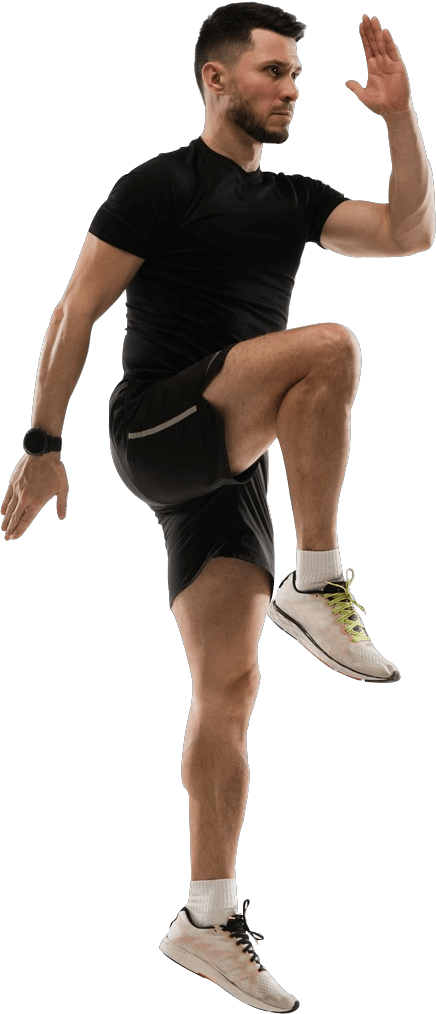We all dream of a well built chest to make our body look better and be more attractive .While the chest can be a tricky muscle to build , supreme exercises like the bench press make it fairly simple
So let’s dive in to the smallest of details of a good bench press that will help your chest grow like never before.
How to do the flat Bench press -My favourite chest exercise
The primary muscles targeted are the pectoralis major (chest muscles), along with secondary involvement of the anterior deltoids (front shoulders) and triceps.
1.Place the barbell on the rack at a height that allows you to unrack it comfortably while lying on the bench.
Ensure that the barbell is evenly loaded with the desired weight plates.
2.Sit on the bench with your feet flat on the floor and knees pointing out, ensuring a stable base.
Lie back and position yourself in the centre of the bench, with your eyes aligned directly under the barbell.
For positioning it’s very important that you have a slight arch in the back while lying which means your back should be squeezed together. Here is what I am talking about
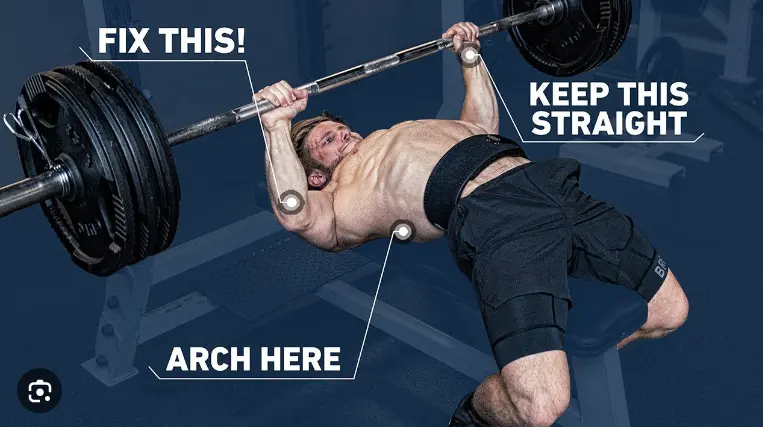
3. Reach up and grip the barbell with your hands slightly wider than shoulder-width apart.
Your palms should be facing forward, and your grip should be firm and secure. Wrapping your thumbs around the bar is recommended for safety.
4. Take a deep breath, engage your core, and lift the barbell off the rack by straightening your arms. Maintain control and ensure that the barbell is directly above your chest.
5. Slowly and under control, lower the barbell towards your lower chest while maintaining a slight arch in your lower back.
Keep your elbows at a 45-degree angle (crucial factor)from your body.
What this means is that your elbows shouldn’t flare out at exactly 90 degrees from your body as this risks serious shoulder injury
6. Once the barbell touches your chest or hovers slightly above it, hold this pose for about 1 to 2 s so that muscle is under more tension, drive your feet into the ground, and push the barbell back up to the starting position.
Exhale as you exert force during the pressing phase.
Pro tip:
1)Don’t move the barbell straight up and down instead move in a curved path. Here’s what I am talking about
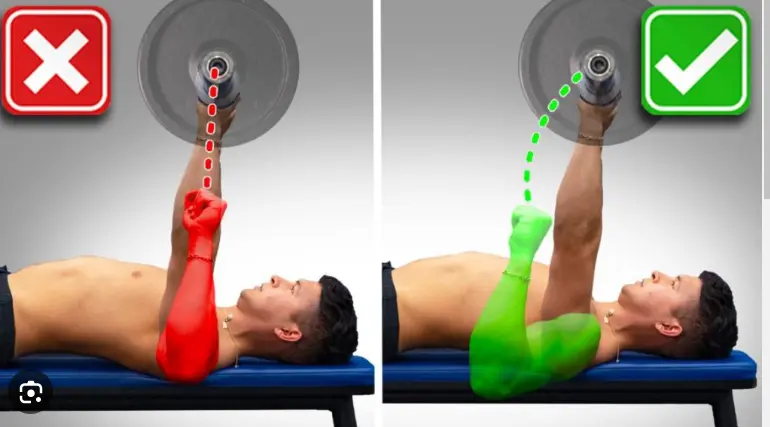
2)Start with a barbell without weights to get proper form and technique and then you can progressively overload.
3)Make sure your shoulders are minimally involved during the exercise
You don’t wanna get confused about what length barbell you need, Do you? Well, we got you covered in this detailed article:what length barbell do you need
Related Articles:
the proper way to train glutes
How to do the Incline bench press-My second favourite chest exercise
This exercise primarily targets the upper portion of the pectoralis major (upper chest), with secondary involvement of the anterior deltoids and triceps.
This is my favourite upper chest exercise.
1.Place the barbell on the rack at a height that allows you to unrack it comfortably while lying on the bench.
Ensure that the barbell is evenly loaded with the desired weight plates.
2.Sit on the bench with your feet flat on the floor and knees pointing out, ensuring a stable base.
Lie back and position yourself in the centre of the bench, with your eyes aligned directly under the barbell.
For positioning it’s crucial that you have a slight arch in the back while lying which means your back should be squeezed together. Here is what I am talking about
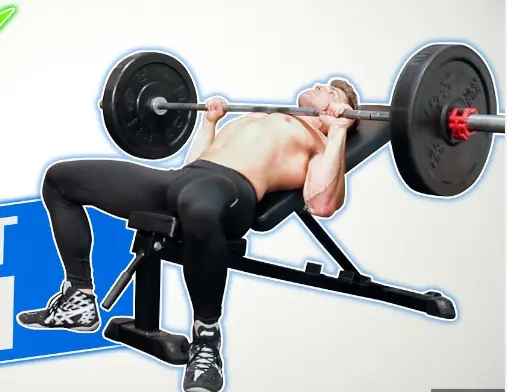
3. Reach up and grip the barbell with your hands slightly wider than shoulder-width apart.
Your palms should be facing forward, and your grip should be firm and secure. Wrapping your thumbs around the bar is recommended for safety.
4. Take a deep breath, engage your core, and lift the barbell off the rack by straightening your arms. Maintain control and ensure that the barbell is directly above your chest.
5. Slowly and under control, lower the barbell towards your middle chest while maintaining a slight arch in your lower back.
Keep your elbows at a 45-degree angle (crucial factor)from your body.
What this means is that your elbows shouldn’t flare out at exactly 90 degrees from your body as this risks serious shoulder injury
6. Once the barbell touches your chest or hovers slightly above it, hold this pose for about 1 to 2 s so that muscle is under more tension , drive your feet into the ground, and push the barbell back up to the starting position.
Exhale as you exert force during the pressing phase.
Pro tips:1)Don’t move the barbell straight up and down instead move in a curved path. Here’s what I am talking about
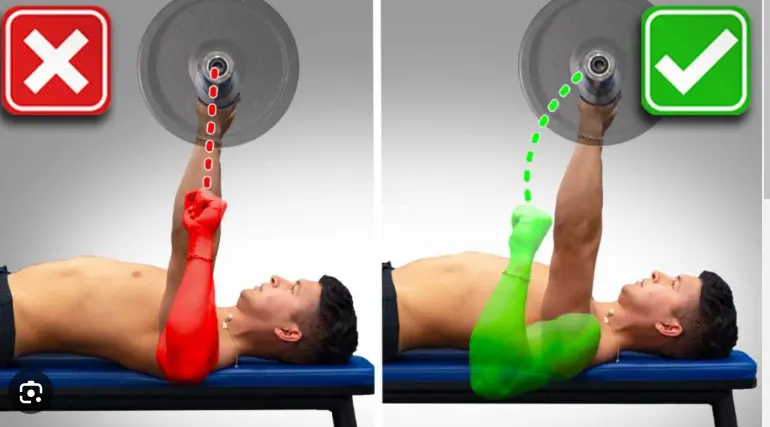
2)Start with a barbell without weights to get proper form and technique and then you can progressively overload.
3)Make sure your shoulders are minimally involved during the exercise
How to do the Barbell Decline Bench Press
The focus of this exercise is on the lower portion of the pectoralis major (lower chest), along with secondary involvement of the anterior deltoids and triceps.
1.Adjust the decline bench to your desired angle, typically between 15 to 30 degrees. Ensure that the barbell is evenly loaded with the appropriate weight plates.
2.Sit on the decline bench with your feet securely placed under the foot pads or anchored firmly on the ground.
Lie back and position yourself so that your head is lower than your hips, with your eyes aligned directly under the barbell.
3. Reach up and grip the barbell with your hands slightly wider than shoulder-width apart.
Your palms should be facing forward, and your grip should be firm and secure.
4. Take a deep breath, engage your core, and lift the barbell off the rack by straightening your arms.
Maintain control and ensure that the barbell is directly above your chest.
5. Slowly and under control, lower the barbell towards your lower chest or midsection while maintaining a slight arch in your lower back.
Keep your elbows at a 45-degree angle from your body.
6. Once the barbell touches your chest or hovers slightly above it, hold it for 1-2s, drive your feet into the ground and push the barbell back up to the starting position.
Pro tips:
1)Don’t move the barbell straight up and down instead move in a curved path. Here’s what I am talking about
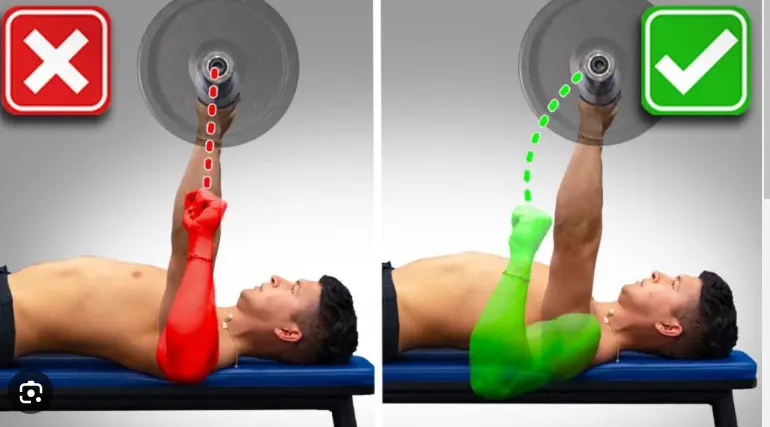
2)Start with a barbell without weights to get proper form and technique and then you can progressively overload.
3)Make sure your shoulders are minimally involved during the exercise
Common mistakes in bench press
Here are the 12 common mistakes
Lack of Warm-Up: Skipping a proper warm-up can increase the risk of injury, warm up your shoulders, chest, and triceps with dynamic stretches and lighter sets of the bench press before attempting heavier weights.
Incorrect Grip: Using the wrong grip width can put unnecessary strain on your wrists, shoulders, and elbows. A proper grip width is typically slightly wider than shoulder-width, allowing for a strong and stable position.
Arching the Back Excessively: While a slight natural arch in the lower back is normal during a bench press, excessive arching can lead to injury. Focus on maintaining a neutral spine position and engaging your core muscles to provide stability.
Flat back: I have seen people doing the bench press laying flat on the bench like it’s a bed! It shouldn’t be like that. Instead, a slight arch in the back is necessary.
Bouncing the Bar off the Chest: Letting the bar bounce off your chest can lead to ribcage and shoulder injuries. Moreover, control the descent of the bar and gently touch your chest with control before pressing it back up.
Lifting the Hips: Sometimes referred to as “butt lifting,” this involves raising your hips off the bench to assist with the lift. This reduces the effectiveness of the exercise and can strain your lower back.
Flaring the Elbows: Allowing your elbows to flare out at a 90-degree angle can stress your shoulder joints. Instead, keep your elbows at about a 45-degree angle to your body to reduce strain on your shoulders.
Lack of Stability: Failing to maintain stability throughout the lift can lead to uneven pressure on your shoulders and potential injury. Squeeze your shoulder blades together, keep your feet planted firmly on the ground, and maintain a strong connection with the bench.
Using Momentum: Jerking the bar off the chest using momentum instead of controlled strength reduces the effectiveness of the exercise and can lead to muscle imbalances or injury.
Neglecting the Eccentric Phase: The eccentric (lowering) phase of the bench press is just as important as the concentric (lifting) phase. You have to control the descent of the bar, maintaining tension in your muscles.
Ignoring Spotter Assistance: Especially when lifting heavy weights, having a spotter can provide an added layer of safety. Therefore, don’t hesitate to ask for assistance when needed.
Improper Breathing: Breathing plays a crucial role in maintaining stability and generating power. Inhale deeply before lowering the bar, and exhale forcefully as you push the bar back up.
Why is bench press the best chest exercise?
Compound Movement(best): The bench press is a compound exercise, meaning it targets multiple muscle groups simultaneously. It primarily works the pectoral muscles (chest), but also engages the triceps, deltoids (shoulders), and even engages the core for stability. Moreover, this allows you to work several major muscle groups in one exercise.
Strength and Mass Building: Due to its compound nature, the bench press allows you to lift heavier weights compared to isolation exercises and by lifting heavier weights under controlled conditions, you can stimulate muscle growth and strength development more effectively.
Time Efficiency: Performing compound exercises like the bench press can save time by working multiple muscle groups in a single movement. This is particularly beneficial for those with busy schedules or lazy people like me.
Benchmarks and Progression: The bench press is a widely recognized strength benchmark and is often used to track progress. Furthermore, many strength training programs use the bench press as a foundation to gauge improvement over time.
Variety of Variations(best): While the flat bench press is the most common, there are various bench press variations such as incline and decline bench presses that target different parts of the chest and shoulders. This variety allows for well-rounded chest development.
Muscle Activation: Research suggests that the bench press activates a significant portion of the muscle fibers in the chest muscles, leading to effective muscle recruitment and growth.
FAQS
How do you bench press for beginners?
Lie on a bench, grip the bar slightly wider than shoulders, lower it to chest, then push it up. Keep back, feet, and shoulders stable.
What are the 5 steps to bench press?
- Lie on bench.
- Grip bar.
- Lower to chest.
- Push up.
- Maintain stability.
Why is my bench so weak?
Possible reasons: lack of practice, improper form, muscle imbalances, not enough strength training.
How do I activate my chest for bench press?
Squeeze shoulder blades, arch back slightly, focus on pushing through chest while lifting, use controlled motion.
Why can’t I feel bench press in my chest?
Possible reasons: Improper form, shoulders/triceps taking over, not engaging chest muscles effectively, bar path not optimal. Adjust form, focus on muscle activation, try lighter weights, consider professional guidance.
Conclusion
If you follow these techniques we gaurantee fast results. What excuses are you left with now? Hit the gym and grow that chest using the best chest exercise: bench press.
About me

Hi, I am Abdullah, a guy whose passion for fitness led to his bachelor’s degree in exercise science, for me what started as a personal fascination soon transformed into a professional career. Over the last six years, I have had the privilege of guiding and supporting numerous individuals on their own fitness journeys. Whether they were beginners taking their first steps into the gym or seasoned athletes aiming to break their personal records, I have been there every step of the way, providing personalized training programs tailored to their unique needs and goals.

